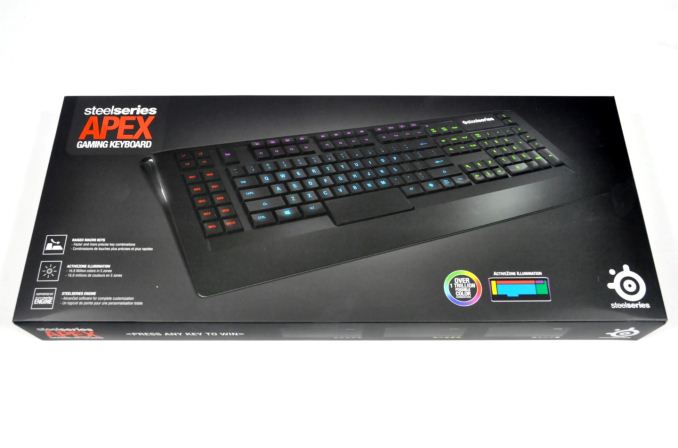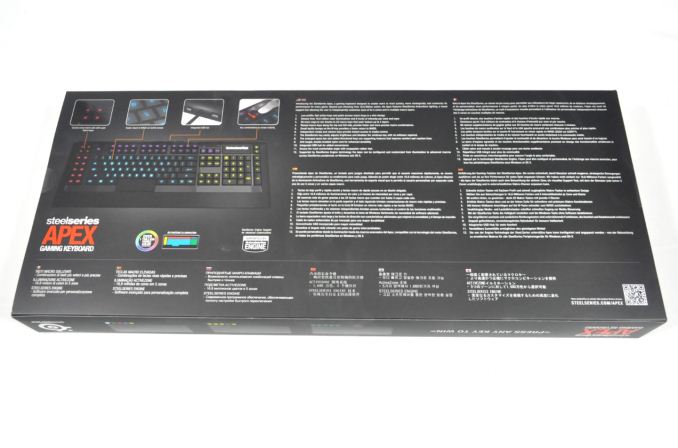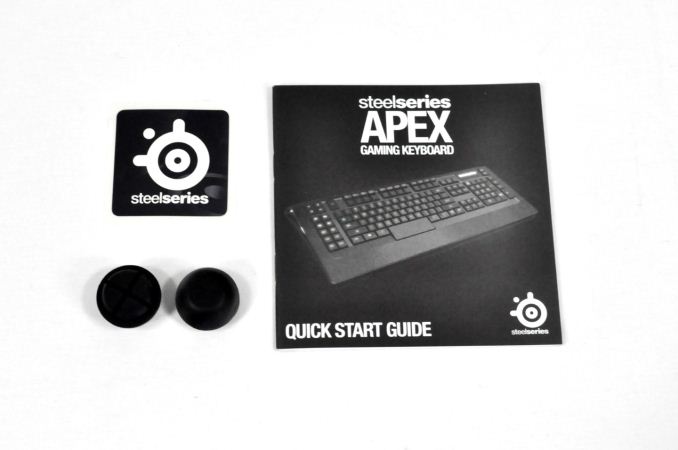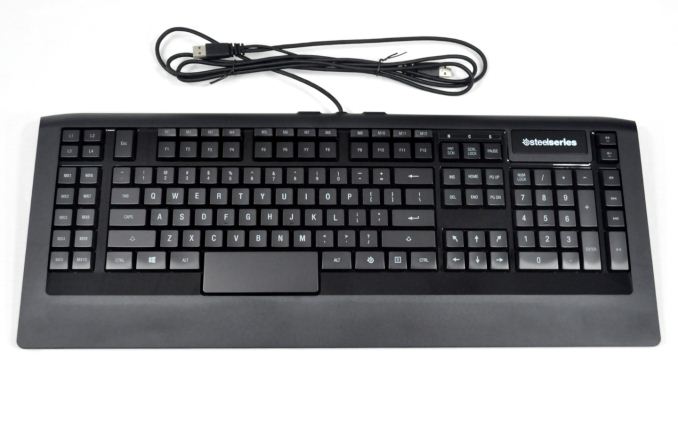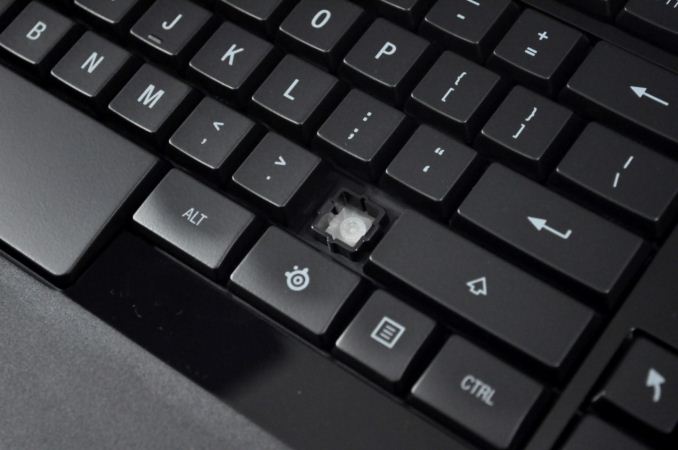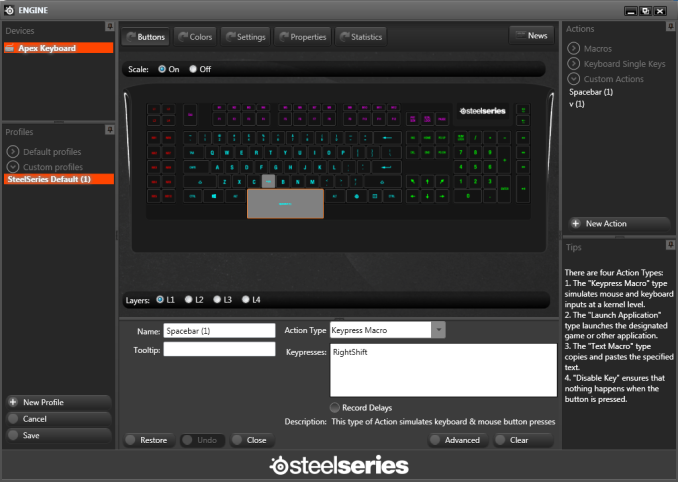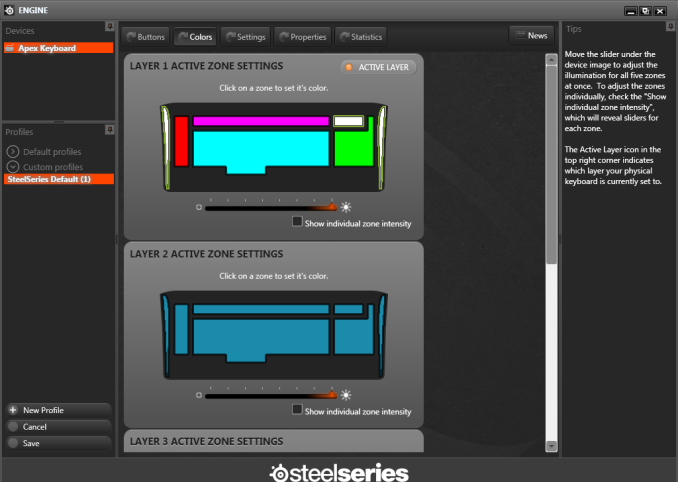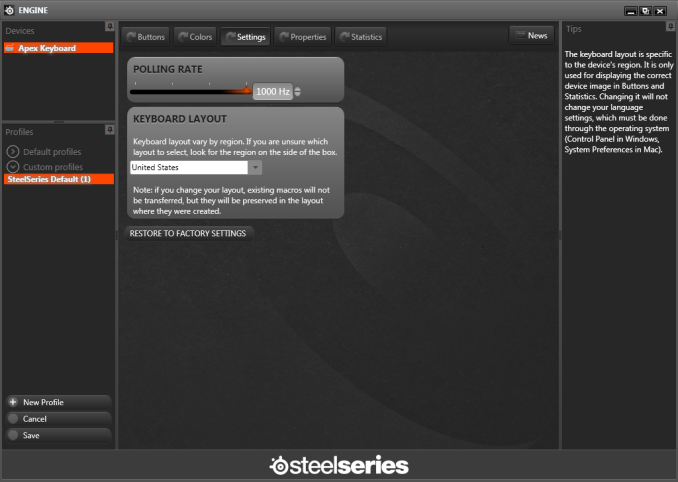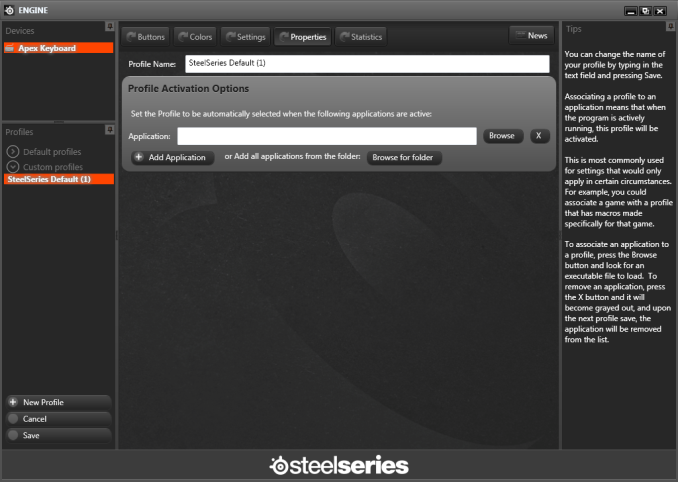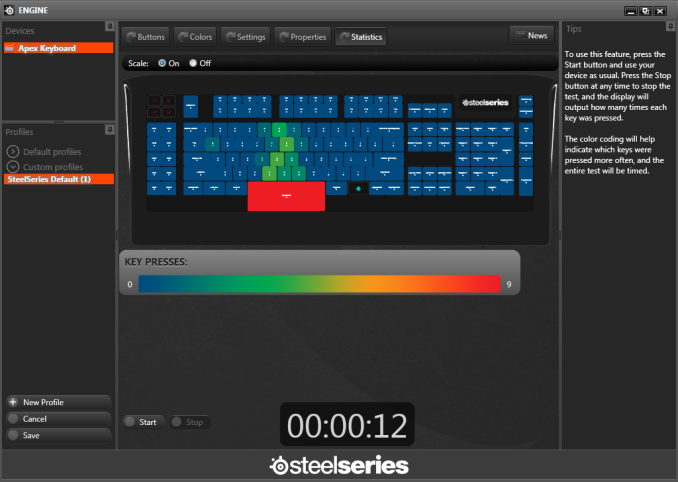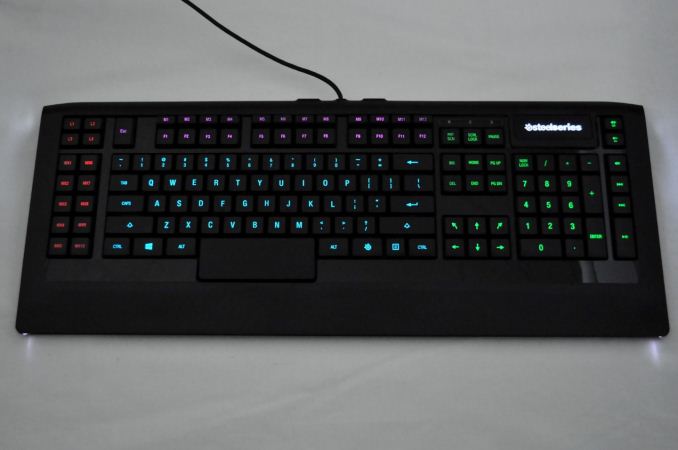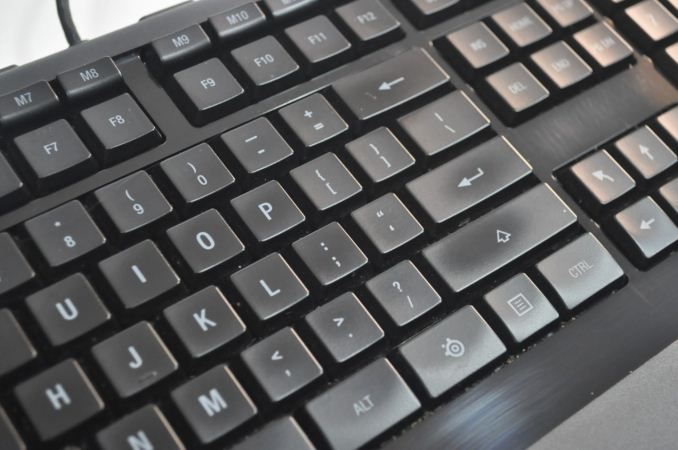
Original Link: https://www.anandtech.com/show/8614/steelseries-apex-gaming-keyboard-capsule-review
SteelSeries Apex Gaming Keyboard Capsule Review
by E. Fylladitakis on October 20, 2014 2:00 PM EST- Posted in
- Gaming
- Keyboard
- SteelSeries
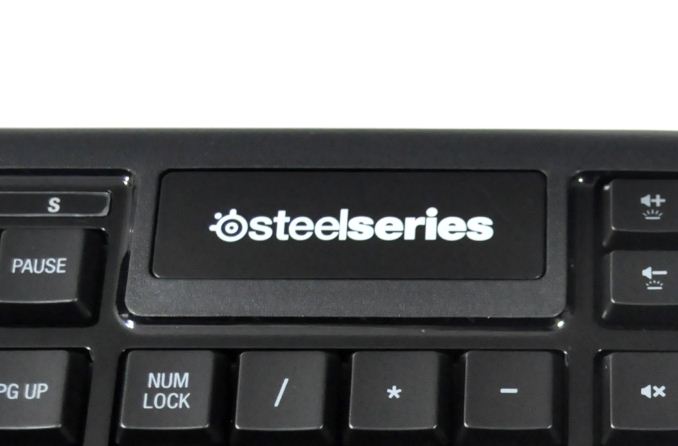
After the hype from Corsair's K70 RGB since its announcement early this year, mechanical RGB keyboards became all the rage. Several companies even managed to beat Corsair to the punch and release an RGB mechanical keyboard first, such as the tenkeyless Rosewill RGB80 that we reviewed several weeks ago. However, what about users that like the prospect of customizable lighting but are either unwilling to spend a lot of money for a keyboard or simply prefer membrane to mechanical keyboards?
SteelSeries has the answer to that question in the form of their Apex Gaming Keyboard. The Apex is a keyboard developed especially for gamers that want customizable lighting and advanced features but would like to stick with classic rubber dome switch keys. It has a very impressive list of features, which we will go through in detail in this capsule review. However, it also retails for $87, placing it dangerously close to the league of good mechanical keyboards.
Packaging and Bundle
SteelSeries supplies the Apex in a simple, effective cardboard box. The artwork on the box is limited to a picture of the keyboard itself, with some information on its most important features printed on the back. Inside the box, the bundle is minimal; there are only two rubber feet, a sticker with the company logo, and a quick start guide.
The SteelSeries Apex Gaming Keyboard
With its numerous extra keys and integrated palm rest, the SteelSeries Apex is a very large keyboard, measuring 56cm (22") wide and 22cm (8.7") tall. It is definitely not a product made for those with limited desk space and will place the mouse a little further to the right than usual. It has an all-plastic chassis in matte black, with a glossy black frame surrounding the keys. An overly large Space Bar key stands out, presumably for extra gaming comfort.
The keycaps are flat, with the bottom row beveled downwards slightly, most likely to avoid accidental key presses when a hand rests on the palm rest. SteelSeries also places a couple of slight bumps on the W key, to help gamers finding it quickly; at least that is what the company claims. Common sense dictates that if a gamer is looking for the W key in the middle of a game it can only mean trouble, and looking at the keyboard might be more efficient, but it might help in a few cases.
The number of extra keys on this keyboard is simply astounding. It has 22 macro keys, ten to the left side and twelve above the F-keys. At the upper left corner, there are four layer keys, allowing you to switch the layer of your current profile. Layers are sub-profiles, meaning that you can have four entirely different layouts programmed into a single profile and swap between them on-the-fly.
There are also two extra arrow keys, diagonally up-left and up-right. These actually are pre-programmed macro keys that will actuate both corresponding arrow keys simultaneously. Finally, there is a row of media keys to the right side of the keyboard, for basic volume and media play control. Unfortunately, the Play/Pause button is likely going to be mistakenly pressed many times instead of the enter button. The same goes for one of the L buttons instead of ESC. It is rather difficult to let go of old habits, though if you use the SteelSeries Apex exclusively you should eventually adapt.
Along the top edge of the keyboard, one USB 2.0 port is on either side of the thin braided USB cable. The sides are also illuminated, shedding some color on the desk. Finally, the bottom of the Apex is entirely flat and plain, without even plastic stands to adjust the tilt. The keyboard can be raised slightly by swapping the two top rubber feet with the taller ones supplied with the keyboard. We found nothing noteworthy inside the Apex except from the LED board under the membrane.
The SteelSeries Engine Software
Perhaps the most important aspect of this keyboard is the software. Through the SteelSeries Engine, the user can access all of the advanced features of the Apex. The software allows for the creation of profiles and the programming of their layers, as well as the programming of macros and special actions.
When recording keypress macros, the user has the option to record the delays as well, and the delays are editable afterwards. Text macros, as the name suggests, insert a specified text nearly instantly into the application. They can be programmed to quickly deliver common in-game messages, such as "Hello!" or "Enemies at my position!". The macro recorder only records key presses, not mouse movements or other events. Keys can also be programmed to launch external applications, or be disabled entirely.
As far as lighting goes, the colors are fully customizable through the second tab (from any possible choice on the RGB scale) but there are limitations. The lighting of the keys cannot be controlled individually; instead, there are five zones, each of which can be set to a different color, with the color automatically affecting every key of the zone. The five zones consist of the main area of the keyboard, the left side macro/layer keys, the function/top macro keys, the numpad/arrow keys, and the fifth zone includes just the sides of the keyboard and the company logo.
From the third tab, called "Settings", users can adjust the polling rate and the keyboard layout. Changing the layout is a handy option for those using multiple layouts, allowing the change of layouts via profiles. Reducing the poll rate of the keyboard however does not seem like an option with any practical use.
Profiles can be set to activate automatically once an application has been launched, or the user can switch between them manually. This option lies within the fourth tab, called "Properties". The lighting of every layer of every profile can be individually programmed as well, allowing the user to choose colors and create visual feedback indicating which profile/layer is currently active. Despite the ridiculous number of macro keys, the keyboard is fully programmable, allowing the user to alter the function of any single key on it.
Finally, there is a tab called "Statistics", which has a keypress counter. The counter has to be started manually and it actually has little practical use, but it is a fun option for those that want to check which keys are being pressed most frequently.
Final Words
In terms of feel, key travel and comfort, the SteelSeries Apex feels just like any good membrane keyboard. Of course it lacks the travel and feeling of mechanical keys; the keys of the Apex feel mushy and need to bottom out in order to register, which is the way all membrane keyboards work. For everyday use, the SteelSeries Apex will do great and in some ways it's even better than common membrane keyboards.
It is comfortable to use, the extra macro keys can be programmed to launch favorite webpages and applications, and its programmability allows the user to adjust the function of any key at will. Multiple layers that can be changed on the fly are handy, especially for those that have a gaming profile with multiple modified keys and need a sub-layer for basic functions, such as chatting. The only thing that will require a learning curve is the position of the media keys and ESC key, as seasoned users will instinctively reach to the edge of the keyboard and press the wrong keys instead.
For gaming, the SteelSeries Apex is a double-edged sword and some of its features are practically unusable. It will work great as long as the game is restricted within the 20 keys that are included in the anti-ghosting areas. True enough, up to six of these keys can be pressed simultaneously and all will register. However, if another key is pressed, chaos ensues. Outside these areas, it is hard for even two keys to register simultaneously, but the real problem is that they will also interfere with the keys inside the anti-ghosting areas.
For example, W-A and Space will all register together, but pressing X or Tab in the process will cause abnormal behavior. Some or all of the keys that are being held pressed might stop registering, or the key that has been pressed might not register at all. In addition, from a practical point of view, only the four (maybe six) top macro keys are usable while gaming. The rest may be used for non-critical gaming actions, like messages and inventory equipment swaps, but obviously it's not possible to reach any of those from the WASD area while gaming without moving your hand away from the normal WASD location.
Finally, the quality of the SteelSeries Apex Gaming keyboard is troubling. As with all keyboards reviewed here, the Apex has been used for seven to ten days, to get a feeling of the keyboard's quality and behavior. These ten days usually include the typing of at least twenty pages every day and some mild gaming. Within that short time period, the keycaps of the Apex have already begun to show obvious signs of wear (i.e. they are getting "polished").
This is expected to occur on very frequently used keys after some time, such as on the WASD keys of someone who is gaming daily for several months; however, this happened on almost all of the keycaps of the Apex within a few days of heavy typing. What would happen if it were to spend a year at the hands of a professional typist is a frightening question. Finally, do note that the glossy black frame that surrounds the keys is extremely easy to scratch, even if a soft cotton cloth is being used to clean it.
In conclusion, the SteelSeries Apex Gaming Keyboard is an overall good product for users that want advanced keyboard features and RGB lighting but are either unwilling to pay the premium price of a mechanical keyboard or simply want to stick with a membrane keyboard instead. On the other hand, the SteelSeries Apex Gaming keyboard retails for $87. If budget is the primary concern over a mechanical keyboard, this price places the Apex dangerously close to programmable mechanical keyboards such as the Rosewill RK-9100 ($90), the Razer Blackwidow UItimate ($100), and the Cooler Master Trigger Z ($120). If programmability is not a primary concern, Corsair also lies in waiting with the Vengeance K70 ($112).
And these are only the mechanical keyboards that threaten the SteelSeries Apex; there are even more membrane keyboard at lower prices (too many to effectively list). They do not have the number of extra keys or the RGB backlighting that the Apex does, but they do have backlighting and are fully programmable. We have a feeling that the SteelSeries Apex cannot really sway users away from purchasing a slightly more expensive mechanical keyboard. It will however appeal to users that want to stick with a membrane-based keyboard and like the layout, the extravagant number of extra keys, the programmable keys and the versatile lighting options.

